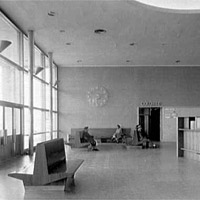 |

超過50年的時間,黑人與白人在等火車時有各自的候車室,例如圖中這個維吉尼亞州的羅阿諾課車站即是如此

|
 |
|
 |
「普萊西對弗格森」 (Plessy
v. Ferguson) 案
1896年5月18日
到了1930年代,種族隔離的政策還是相當普遍。舉例來說,1937年阿肯色州發生水災時,白人災民與黑人災民救被放置在不同的援救場所裡。最後,在聆聽「全國有色人種協進會」 (National
Association for the Advancement of Colored People,NAACP) 一位名叫索古得‧馬歇爾 (Thurgood
Marshall) 的律師答辯之後,最高法院在1954年5月17日推翻了「普萊西控告弗格森」一案的判決。後來在「布朗控告教育部」 (Brown
v. the Board of Education) 一案中,法院無異議的通過哈藍法官在50年前的主張,判決這項隔離政策是違憲的。你對於這種隔離不同種族的法律,以及後來廢止這些不公平法律的判決有多瞭解呢?
By the 1930s, the practice of racial segregation was still widespread. When devastating floods hit Arkansas in 1937, for example, white refugees and black refugees were cared for in separate relief facilities. Finally, after hearing arguments by NAACP lawyer Thurgood Marshall, the Supreme Court reversed the Plessy decision on May 17, 1954. In Brown v. the Board of Education, a unanimous Court agreed with what Justice Harlan had said 50 years ago, that segregation was unconstitutional. What do you know about laws that kept people separated and about later laws that disallowed this practice?

 3/3 頁
3/3 頁

|





